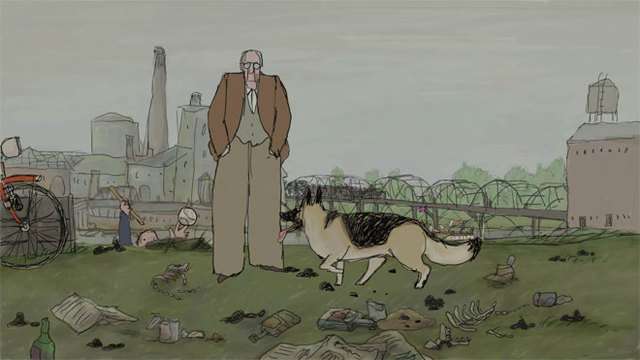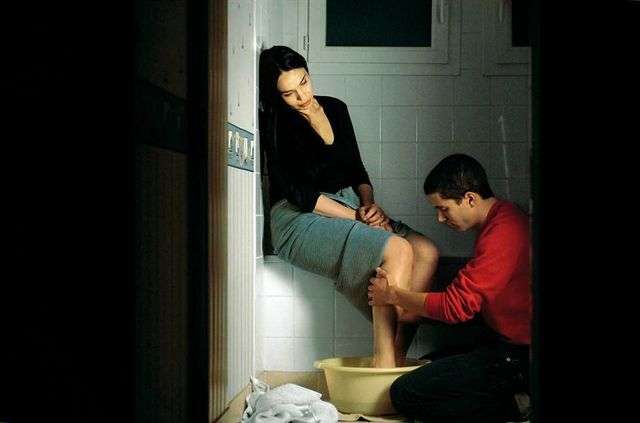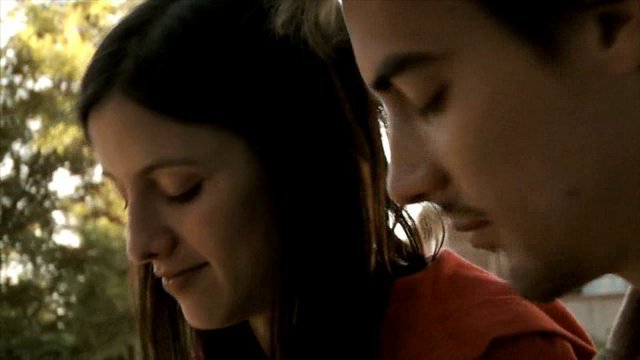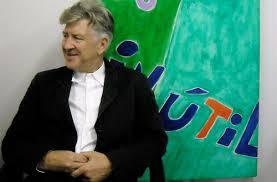-
Hirokazu Koreeda: Air Doll (2009)--SFIFF
Hirokazu Koreeda: Air Doll (2009)

Nobody feels
Bong Joon-ho's contribution to the trilogy film Tokyo! was about one of Tokyo's hikikomori, radical isolates who carry Japanese shyness to an extreme and refuse ever to go outside. We've also seen Ryan Gosling in Lars and the Real Girl, which shows a young man whose significant other is a lifesize sex toy and whose family goes along with the fiction that "she" is real. Now we have Koreeda's Air Doll (Kûki ningyô) , which in a sense blends elements of both these stories. Hideo (Itsuji Itao) is a waiter living in a miserable industrial suburb who comes home every day to Nozomi, his lovely wife whom he bathes, has sex with, serves dinner to, chats with, and says goodbye to every morning. Nozomi is an inflatable doll. However Nozomi has a secret life of her own in the film, which is exquisitely filmed by Taiwonese cinematographer Mark Lee but succeeds more visually than otherwise. She comes to life after Hideo leaves, morphing into a real woman (played by Korean actress Bae Du-na of The Host and Sympathy for Mr. Vengeance) who displays a sweet, innocent enthusiasm for the world. Unlike Bong's hiddomori episode or Lars, this film is a fairy tale rather than social and psychological study, and at times it becomes preachy, or slips into the realms of the sentimental or the obvious. A fundamental weakness of the concept is that when the air doll goes out into the world, she is played by a real live actress and no longer seems like an air doll, despite wide-eyed looks and jerky movements.
Koreeda (After Life, Nobody Knows) has excelled in spinning out wafer-thin subjects about love, loss, and loneliness into compelling films. Here, working from a 20-page graphic short story published in 2000 by manga artist Yoshiie Gouda, he takes the material further than it is quite capable of going. For the Japanese audience the film may have more meaning, playing successfully as it does with the culture's fascination with cuteness, its predilection for extremes of politesse, and for imitation and mimicry -- and, needless to say, the passive role of women. And there is delicacy here, even though it risks being cloying, and there are thought-provoking moments, despite the didacticism.
Nozomi goes out into the neighborhood and develops a life of her own, getting a job at a video shop (a showcase of the make-believe that teaches her about the world) , meeting her maker, discovering she has a heart and falling in love with another man, the young shop clerk, Junichi (Arata), and developing a friendship with a crippled poet, while still returning to perform her passive duties for Hideo. Eventually her two separate lives become incompatible.
The material is fragile and seems the more so from being spun out too long, into nearly two hours. Air Doll would be better, and have more chance of an international life outside festivals, if radically cut, relieved of the many repetitious physical sequences and a lot of the gratuitous philosophizing. It has a nice electronic score, a fearless performance by Bae Du-na, good use of its old neighborhood overrun by ugly rebuilding, many subsidiary characters that rarely develop three dimensions. Perhaps it is best that no one competes with the manikin subject.
Seen as part of the San Francisco International Film Festival 2010. Included in the Un Certain Regard section of the Cannes Festival, 2009. To be released in the US by Palisades-Tratan Pictures.
-
Whang Cheoul-mean: Moscow (2009)--SFIFF

A Korean look at economic realities, class, and friendship
In this lively Korean study of how changes in social status restructure personal relationships, two young women who were friends as young girls meet again and decide to spend time together, with somewhat explosive results. Times have changed and their stations in life are now very different. One now is a lowly secretary at an international corporation, but living a relatively comfortable life. The other is a recently laid off part-time factory worker who has abandoned a hunger strike she shared with her comrades. When they're reunited at the corporate secretary's instigation and stay together for a while, their different economic realities and different perceptions of the world rapidly erode their childhood friendship. This may sound schematic, but intense acting and lively action make it real.
Jin-hee (Sung Su-jung) and Ye-won (Lee Hye-jin) were middle school classmates. Jin-hee is a factory worker turned pro-union labor activist. The intense and nervous Ye-won is somewhat exhausted by the tensions of her corporate job, a job that, as Jin-hee eventually points out to her, is at a place that doesn't allow unions, where workers have to tow the line unquestioningly. When she gets the opportunity to reminisce about the good old days with Jin-hee, Ye-won is eager to do so, and invites her old friend to come for an extended visit even though they now have little obviously in common any more other then a lingering enthusiasm for acting. Ye-won took an acting degree but went nowhere with it. Jin-hee had no such opportunity but shares the dream of acting success.
The fascination of this film is its representation of the economic and political through the psychological and social. This is a process narrative, and the process is one of disintegration and reintegration. At first the two women are like schoolgirls, going around hand in hand, laughing, singing school songs and getting drunk together. Then gradually things go wrong as the charade of comradeship is invaded by the realities of the separate and differently unsatisfactory lives. Jin-hee has no patience with Ye-won's lack of awareness of bad labor conditions in their country. When Ye-won gives Jin-hee a present of a locally made MP3 player whose company brutally exploits its workers, Jin-hee explodes with anger at her insensitivity. Ye-won lives in a bubble, totally aware of the local exploitation of labor.
Later, Jin-hee, who morphs from critic to imitator, begins to seem like the roommate from hell by the way she invades Ye-won's life, wearing her clothes and partying with her work associates and pestering her actor friends to let her audition (she memorizes a scene from Chekhov). Ye-won seethes with resentment, but Jin-hee is disturbed inside too. The honeymoon is over. The gradualness of the process is possible because the two actresses are both young and pretty. You can imagine them as interchangeable, had circumstances been different. Jin-hee's intense, almost pathetic enthusiasm for acting seems to enable her to become another person at times.
The film's title refers to Chekhov's Three Sisters, in which the lead characters long to return to the Russian capital and its imagined perfection. It's a scene from that play that Jin-hee learns. Chekhov's play becomes a constant theme. Its similar focus on vanishing wealth and personal discomfort and aimlessness of the sisters parallels the trajectory of Moscow. Ye-won's bourgeois origins grate on Jin-hee, whose family ran out of money and were forced to leave their home town and robbed her of the key to success -- a university education -- that was automatically provided to Ye-won. Resentment over this fundamental difference fills their current relationship with anger. At the same time Jin-hee is tormented by her loss of confidence in her labor union activities. Perhaps the two have more in common after all -- except for social awareness and economic circumstances.
Lee is subtle in the way she lets Ye-won's unease gradually reveal itself through little details. Sung has to be more overt in her portrayal because her character is less restrained but she's very good in what is a demanding role, and the understated finale where Jin-hee finally finally lets out her true feelings gives her an opportunity to show some nuance too. Both give fine performances, and they make the film work even though it suffers from delayed exposition and an ending that's protracted and anticlimactic. The screenplay by Kim Kyung Hyun could have used some tightening up. But in a male-dominated Asian culture it's good to see a strong, unsentimental drama about the relationship between two women. This isn't as sophisticated as the ironic skewering of male ego in Hong Sang-soo, but it's forceful and engaging.
Seen as part of the San Francisco International Film Festival 2010.
Last edited by Chris Knipp; 05-04-2010 at 10:40 AM.
-
Paul and Sandra Fierlinger: My Dog Tulip (2009)--SFIFF

Dog days are good days
J.R. Ackerley was a writer for the BBC from its foundation in the late Twenties till 1959 who was openly gay, a thing unusual for the time. He wrote with wit, bluntness, and honesty about his remote, but important, relationship with his colorful dad in his remarkable little book My Father and Myself. His semi-autobiographical novel, We Think the World of You, was made into the 1988 film by Colin Gregg with Alan Bates, Max Wall, Liz Smith and Gary Oldman. Despite plenty of sex in his younger years, he never found a life companion in maturity, and he found that the most important emotional connection of his adult life was his relationship with his canine pet, his "Alsatian bitch," which he described in another book, My Dog Tulip. (The dog's actual name, by the way, was Queenie. )
This hand-drawn animated film, which is narrated by Christopher Plummer and includes the voices of Lynn Redgrave, Isabella Rossellini, and others, was adapted from that book. The images are of the charming, old-fashioned, wavery sort, a mixture of black and white line drawings and (more often) drawings colored in with watercolor. The entire film is constantly narrated by lines from the book. Somewhat oddly, when you see Ackerley on screen, he is usually represented as mouthing the words of the voiceover. You can ask yourself if the images were needed, since the words tell he same story. Sometimes events are understood better and more fully experienced in the mind's eye than when drawn for us with painful (or even witty) literalism. But the film brings the book, and Ackerley's wit and honesty, to a new audience.
The book certainly is suited to animation rather than other form, since it consists so largely of events it would be difficult to stage and unpleasant to watch. Events, that is, like Tulip relieving herself at untimely moments, "marking" objects outdoors; and a lengthy effort to mate Tulip with a male Alsatian. The latter fails, though she eventually mates with a little mutt and has eight puppies, which Ackerley is immediately forced by his landlord to get rid of. He considers drowning them, but gives them away. He admits he doesn't do so responsibly, since he kept no track of where they went. And Tulip herself had an unfortunate upbringing, which Ackerley thought led to her skittishness, excessive barking, and almost pathological eagerness to go on walks.
Ackerley took in his adult sister for a time in his Putney flat, partly to keep Tulip company while he was at work. A competition developed for Tulip's affections, but Ackerley won. There are various other characters, rude shopkeepers, owners of would-be mates for Tulip. Through a weekend with a former fellow officer we learn something about Ackerley's service in WWI.
This film is amusing. It is accurate in a way most accounts of canine pets are not. You won't get the profound understanding of canines of a Konrad Lorenz or César Milan. In fact Ackerley dramatizes how comically ignorant humans are of dogs' inner workings.
The book does not tell all. Its focus is very limited. Ackerley's relationship with Tulip (Queenie) was central in his life during those 16 years, which he says were the happiest of his life. Elsewhere we learn they were his most productive, partly because of his happy state, partly because Tulip's behavior in company reduced Ackerley's social life and so gave him more time to be writing. Considering that this was the relationship's central importance there might have been more about the physical affection between man and dog, the companionship, and how Ackerley drew sustenance from these. It seems somewhat peculiar that when Ackerley is talking about the more complex side of male-female canine relations the animators switch to black-and-white drawings of upright humans with canine heads and paws. It's their choice, not Ackerley's. Oddly, there is nothing about feeding the dog. But you clearly see how much of Ackerley's life was devoted to Tulip's needs, and you get a sense of how satisfying that was to him.
Despite shortcomings, My Dog Tulip is a significant contribution to the literature of canine-human relations and a chance to hear a wonderfully dry, articulate English voice of the Fifties. The film premiered at Cannes and was well received at Annency, Vancouver, Toronto, and other festivals. I saw it as part of the San Francisco International Film Festival in April 2010.
Last edited by Chris Knipp; 05-04-2010 at 10:46 AM.
-
John J. Healey: The Practice of the Wild (2010)--SFIFF
John J. Healey: The Practice of the Wild (2010)

GARY SNYDER WITH HIS DOG AND JIM HARRISON
A glimpse of Gary Snyder
This rambling short documentary about poet Gary Snyder's life and poetry begins with him saying some words from his book, The Practice of the Wild: “The wild requires that we learn the terrain, nod to all the plants and animals and birds, ford the streams and cross the ridges, and tell a good story when we get back home.” At one point in the film, Snyder mentions his distinction in the book between "nature," "the wild," and "wilderness." These are tantalizing hints at what the film might have been, an elucidation and extension of Snyder's complex and fascinating 1990 book, a collection about mankind's responsibility to the wild and duty to maintain a proper place on the planet and in his own space.
But that is not exactly what happens. The film instead mixes conversation at a dinner table, chats walking and sitting between Snyder and his friend Jim Harrison, readings by Snyder of a few of his poems, and historical footage with biographical notes on Snyder's whole life, his studies of Chinse poetry, years in Japan, some of it at a Zen monastery, his participation in the legendary Six Gallery poetry reading in San Francisco on October 7, 1955 (his poem about ritual, "A Berry Feast," came last, right after Allen Ginsberg's "Howl"), his move to the Sierra foothills, his long stint teaching at UC Davis. There are some valuable talking head comments on the "Beats" by Philip Whalen and Snyder's interest in the Orient by his former wife Joanne Kyge.
Linguist, poet, mountaineer, environmentalist, archeologist, teacher, lumberman, Zen Buddhist -- the number of roles Gary Snyder has played, the places he has lived, would strain a long, detailed documentary. Since the Eighties he has been more an environmentalist and at times seemed less of a poet, though the poetry has continued and has always expressed similar concerns.
This little 53-minute film is a nice introduction to Snyder or a souvenir for admirers. But as a treatment of the topic of the essay book it is a disappointment, and it seems like a hodgepodge, all relevant, because the man is so complex yet so unified, but superficial, when the ideas in the book are profound and challenging. Recommended: read what you can of Gary Snyder's Practice of the Wild. If you come away understanding a fourth or a fifth of it, you'll be lucky. And by all means read Snyder's poetry. Unlike Dylan Thomas, Edith Sitwell, T.S. Eliot, Robert Frost, Yeats, and some others, Snyder isn't a poet whose speaking voice seems essential to the appreciation of his texts.
The Practice of the Wild, the film, was produced by Jim Harrison and William R. Hearst III, and edited by Robin Lee. It is a production of San Simeon Films, San Francisco. Seen as part of the San Francisco International Film Festival 2010.
Last edited by Chris Knipp; 08-06-2014 at 12:52 PM.
-
Patric Chiha: Domain (2009)--SFIFF
Patric Chiha: Domain (2009)

BÉATRICE DALLE, ISAÏE SULTAN IN DOMAIN
Gödel, alcohol, gayness
The new French film Domain (Domaine) by the Austrian director Patric Chiha, his first feature, should mainly be seen as a vehicle for the talents of the legendary, iconic Béatrice Dalle, for whom Chiha wrote the screenplay. Dalle has been in more than 35 films but may still be most remembered for her stunning debut performance (with the equally intense Jean-Hugues Anglade) in the 1986 Jean-Jacques Beineix film about a young woman going mad, Betty Blue (37°2 le matin). She also had a vivid small role in Claire Denis' intriguing 2004 film The Intruder (L'intrus). Dalle is the kind of off-kilter, stunningly assured performer you can't take your eyes off of. However, Domain irritates at least as much as it pleases with its "auteurist" pretensions and unconvincing or underdeveloped elements.
Nadia (Dalle) is a mathematician who is pursued by her lyçée student nephew Pierre (Isaïe Sultan) because he finds her far more interesting than his classmates or his own family; but in the course of the film her descent into alcoholism, which Pierre at first minimizes, eventually leads him to abandon her. He has begun to find his classmates more interesting and, perhaps more important, he has acknowledged his gayness by taking on a friendly, upbeat 26-year-old boyfriend -- though Nadia's decline remains the main focus of the film to the end.
One element that has been questioned is designating Dalle as a mathematician (specializing in Gödel, no less). For an actress who is best at playing a madwoman or an eccentric, this occupation seems unlikely, and it's a detail apparently added in to the screenplay as an afterthought to give Nadia something to do, or have done up to her current decline. Pierre is a perfect-looking young man who smiles a lot. His rejection of his family guidance, represented by little conversations in the kitchen with his mom, Jeanne (Tatiana Vialle), seem to cause him as little discomfort as his being gay. As Pierre, Isaïe Sultan's acting consists mostly of that smiling, and finally some crying. Everything is too easy for him to be true. He gets a perfect boyfriend called Fabrice (Manuel Marmier) simply by having a little conversation on a bus. If that's how it works in Bordeaux, where the main action takes place, all young gay men should consider moving there. Fabrice leads Pierre to spend fewer afternoons with Nadia, who seems to need Pierre more then he needs her.
Chiha has Nadia spout a lot of ideas about order, and how to walk (fast, with a good rhythm). Her relationship with Pierre at first consists of frequent after school strolls in the park. Later they go to cafés or clubs where she gets drunk and he has to help her home. Some have said this is a very French film, but it seems a very Austrian one, with its focus on geometry, direction, cleanness, order, and its finale in an Austrian resort hotel where Nadia goes for a cure, where Pierre visits her, but finds she has only sunk into greater despair. She sees her alcoholism as a decline into chaos. The word "Domain" itself suggests an area of control. This movie seems to have a weak grasp of the actual. It avoids movie clichés of alcoholic behavior, but loses touch with reality in its exclusive focus on an odd relationship between a teenager and a forty-something woman that lacks motivation and depth.
We are forced to endure pointless scenes at bars with the only friend of Nadia who doesn't abandon her, a dubious character called Samir (Alain Libolt), or eating bad pizza at home, again with Samir, or watching a gaunt gay cabaret singer whose stage name is Joan Crawford. The music is alternately too light or too obtrusive, and the low-light scenes have poor image quality, though landscapes and closeups of the two principals are fine.
There are lots of faults in Domain. And yet the very preposterousness of the connection between Pierre and Nadia and the theatricality of their brisk walks wind up making their relationship memorable. Isaïe Sultan has enough presence to hold his own with Dalle, and Dalle is hypnotic and fun to watch, a figure of such defiant assurance that you can almost believe anything attributed to her. And the actress' own history of substance problems adds conviction to her performance as someone who finally says drinking is "all I do." This film, which opened April 14, 2010 in France, did only moderately well with French critics according to an Allociné rating of 2.19/35; some found it interesting, others not, but all praised Dalle.
Seen as part of the San Francisco International Film Festival 2010.
Last edited by Chris Knipp; 05-05-2010 at 10:42 PM.
-
José Manuel Sandoval: Te creís la más linda (2008)--SFIFF
José Manuel Sandoval: Te creís la más linda (2008)

CAMILLA LE-BERT AND MARTÍN CASTILLO IN TE CREÍS..
Boy talk
Martín Castillo plays Javier, the slim, doe-eyed, slightly scruffy 19-year-old hero of this very vernacular, talky, flavorful Chilean youth picture written by the 25-year-old José Manuel "Che" Sandoval, divided into diaristic chapters with chatty headings and titled overall You Think You're the Prettiest, But You're the Sluttiest -- Te creís la más linda (pero es la más puta). Camila Le-bert is Valentina, the neighbor he would like to make his girlfriend. Francisco Braithwaite is Javier's artsy best friend Nicolas, whose talk is even more pungent than Javier's. With his playful, nonstop jive talk, Javier negotiates Valentina into going to bed with him -- he's nothing if not a talker -- but then very soon afterward she sleeps with Nicolas, so Javier tries to make it with Nicolas' regular girlfriend in revenge, but she's not interested. Then he goes on a little odyssey, winding up more bedraggled than ever but just as charming and indomitable, as the film ends, in front of Valentina's house.
This is the modern generation, whose talk is slangy and dirty and focused on "soccer, video games and the content of your iPod," as a festival blurb intones. This cinematic chronicle of a couple days in a young man's life, which was young Sandoval's thesis for film school, is more about a needy, ironic sensibility than about any specific events. Castillo is remarkable, mouthing Sandoval's lines as if he wrote them himself -- a lot of the time he is improvising them. Sometimes, especially in the early dialogue when he's wooing Valentina, the chatter so concentrated on wordplay and showing off that it almost makes no sense, but that's when it's best, when the film really sings.
And anyway, it's obvious what Javier's about. The defining moment comes when, after a long night leaves him battered and bruised in the morning, Javier sidles up to an aging prostitute, the real thing. ("Puta," prostitute, is one of the kids' favorite words. ) With motor-mouthed eloquence Javier tells her, speaking for himself and the audience more than for her, that the ones who give it away for free are more "puta" than she is, who is a "puta" only as a job -- and, moreover, she says only on Saturdays. She's really old. But as she speaks, her face becomes both beautiful and elegant. She may indeed have more class that the girls Javier tries to take to bed. Trying to live the "puta" life is all he does himself, he also declares; he just doesn't succeed: he's "an expert at fucking up."
People come and go and tell their stories, most lamely a guy at a bar who says his girlfriend has gone off to Spain to study art, emptied their house, which belonged to her family, and sent off their two kids to be cared for elsewhere. Javier isn't moved. He thinks his sufferings are equal. He's the center of his world. We never see his parents. Valentina's mother is only a voice from her house. The way Javier slips back into a conversation with Valentina after the closing credits is typically sly and natural. This kid never succeeds but he never quits either. He is the embodiment of a certain kind of youth.
Te creís la más linda (pero es la más puta) premiered at the Valdivia Film Festival in Chile in 2008. The cast also includes Andrea Riquelme (Francisca), Sebastian Brahm, Paula Bravo, Grimanesa Jimenez (the prostitute), and someone or something called Ramirez! The cinematography is by Felipe Bello; the editing is by Manuel Piña (who doubled on the sound) and Sandoval. The film was shown as part of the San Francisco International Film Festival 2010, in competition for the New Directors Prize. Not much other information is available about it on the English-language Internet, but it has been in other festivals, as its trailers show. It has something in common with Alex dos Santos' 2006 Glue and the films of Fernando Eimbcke and Gerardo Naranjo. It's especially notable for its emphasis on the rhythms of contemporary language, and its motor-mouthed hero is a portrait of a sensibility that is both of today and classic. Times have certainly changed, but there is something of Holden Caulfield in Javier. This is a 21st-century Hispanic Holden struggling to maintain the integrity of his fledgling male ego. Another vivid illustration of the energy of Latin American filmmaking: Che Sandoval is a young director to watch.
Currently (June 1, 2014) you can watch the whole film on YouTube here with English subtitles: enjoy.
Last edited by Chris Knipp; 06-01-2014 at 10:51 AM.
-
Marcos Andrade: Transcending Lynch (2009)--SFIFF
Marcos Andrade: Transcending Lynch (2009)

LYNCH PREPARES TO MEET THE PUBLIC IN TRANSCENDING LYNCH
David Lynch in Brazil, talking about TM and dropping hints
David Lynch, the great American filmmaker, is a distinctive-looking man with a bland, pasty face, pale blue eyes, and an impressive mound of sleek, wavy hair. He wears well cut-suits with good white shirts, often buttoned up without a tie. He smokes and drinks many cups of espresso. When he speaks, the American twang of his voice surprises. For 35 years, since he made his first film, Eraserhead, he has practiced Maharishi Mahesh Yogi's "transcendental meditation" (TM) twice a day. He rarely speaks of his work as a filmmaker without mentioning this, and saying that it has enabled him to deal with the dark side of his consciousness, as well as with the nervousness and fear he once felt. (Obviously the stylish and original way his films explore that dark side is the chief source of their fascination.) Recently Lynch went on book tour with the singer Donovan to talk about his Catching the Big Fish: Meditation, Consciousness and Creativity and promote an interest in transcendental meditation. Marcos Andrade is a native of Rio de Janeiro who studied filmmaking in New York. His first film was the 2004 Korda, a wordless story of a solitary man. Practicing TM himself for a few years, Andrade became involved with the David Lynch Foundation through his meditation teacher. Andrade made this, his first documentary film, by following the Brazilian leg of Lynch's TM book tour.
It's not a sure thing that this film will convert you to TM, or even tell you much about it. This is best seen as a film about David Lynch, one with not much substance in itself, but of value to anyone who truly admires the man's work, who perhaps has met the man before, or just heard him in a Q&A, caught a appealing whiff of his aura, and wanted to catch more. In numerous chats and public appearances during the film, Lynch tends to dodge the inevitable requests for, say, the meaning of the blue box in Mulholland Drive, or a list of his favorite contemporary filmmakers, but the aura is there, and sometimes though smilingly refusing to explain anything he draws a nice picture of the genesis of a film -- a song, say, red lips, green grass at night, an ear found in a wood, a mystery "somewhere" (Blue Velvet) These little asides have more value than the more airy declarations about TM and what it can do for you.
Similar comments about the book's limitations can be found on Amazon. Publisher's Weekly bluntly says "Lynch's rants lack cohesion and substance." Lynch paints and draws, he dabbles in music, he writes, and who knows what else, while he's waiting for the idea for his next film to come to him. No need to pretend these other things matter the way Blue Velvet or Mulholland Drive or Inland Empire do. But there is always something about the man, that, if you transcend yourself and attend to it, gives watching and listening to him an almost ineffable value so long as you've ever been touched by the magic of his films.
Andrade sometimes indulges himself in little riffs of his own, like wordless passages of Lynch and his tour organizer talking, without sound, as "Blue Velvet" plays and we gaze through a blue filter; or shots, deliberately allowed to run on too long, of a crowd wandering round at a reception; a walk through an airport run backwards. We can be patient with those, and this is a film about patience. Lynch is also a model of how to respond helpfully and with good humor to endless annoying questions. Some of them are obvious, like the answer to "What is your favorite among your own films?" -- they're like children, and I love them all equally -- but Lynch replies with unusual enthusiasm and panache. He's a good intuitive teacher. He even compares transcendental meditation to the good times he spent in Los Angeles at Bob's Big Boy Diner drinking coffee and chocolate milkshakes. It provides a safe place from which you can contemplate the darkest ideas. And "a good story," he casually remarks, requires conflict, pain, dark moments.
Brazil plainly loves Lynch,and how could he not keep his good humor receiving constant adulation? But this film may have done more good for him than it does for us. Still, it has its moments, for the Lynch fan, of which I am one. He drops a few useful hints about how David Lynch films come into existence.
Seen at the San Francisco International Film Festival 2010.
Last edited by Chris Knipp; 06-01-2014 at 10:31 AM.
 Posting Permissions
Posting Permissions
- You may not post new threads
- You may not post replies
- You may not post attachments
- You may not edit your posts
-
Forum Rules





 Reply With Quote
Reply With Quote






Bookmarks